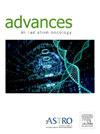Exploring the Role of Radiosurgery for Atypical Meningiomas: Addressing Suboptimal Local Control in High-Risk Patients
IF 2.2
Q3 ONCOLOGY
引用次数: 0
Abstract
Purpose
Despite recent advancements in the treatment of atypical meningioma, control rates in high-risk patients continue to be suboptimal. Stereotactic radiosurgery (SRS) offers the ability to achieve improved local control (LC) with a low toxicity profile. However, available data are limited. We aimed to conduct a comprehensive review of a consecutive cohort of patients diagnosed with high-risk atypical meningioma who underwent SRS, either as a single-fraction SRS or in the hypofractionated SRS (hf-SRS), and evaluate the LC rates (LCR) with a specific emphasis on patterns of treatment failure.
Methods and Materials
We identified consecutive patients diagnosed with high-risk World Health Organization grade 2 meningioma treated with SRS at a single institution between 2014 and 2021. High-risk meningioma was defined as a residual disease or recurrence after initial gross total resection. Follow-up data were analyzed to evaluate LCRs and patterns of treatment failure. We defined local failure as tumor recurrence wthin the prescription isodose line, marginal failure as recurrence within 5 mm but outside the prescription isodose line, and distant/regional failure as recurrence beyond 5 mm of the prescription isodose line but within 2 cm of the surgical cavity.
Results
We identified 45 pathologically confirmed atypical meningiomas in 25 patients. Thirty-three tumors underwent single-fraction SRS, and 12 tumors received hf-SRS. The median follow-up was 36 months (range, 2-86 months). The 3-year LCR was 84.6%, and overall survival was 96.0%. Four patients with a total of 7 tumors experienced treatment failure. Failures were either local (3 patients and 3 lesions) or marginal (3 patients and 4 lesions). Patients treated with hf-SRS did not exhibit local, marginal, or distant failures.
Conclusions
Our institutional data on atypical patients with meningioma treated with radiosurgery compare favorably to existing literature using fractionated radiation therapy. SRS offers a promising strategy to improve LC in this patient population, and the occurrence of marginal failure plays a role in creating clinical target volume margins.
求助全文
约1分钟内获得全文
求助全文
来源期刊

Advances in Radiation Oncology
Medicine-Radiology, Nuclear Medicine and Imaging
CiteScore
4.60
自引率
4.30%
发文量
208
审稿时长
98 days
期刊介绍:
The purpose of Advances is to provide information for clinicians who use radiation therapy by publishing: Clinical trial reports and reanalyses. Basic science original reports. Manuscripts examining health services research, comparative and cost effectiveness research, and systematic reviews. Case reports documenting unusual problems and solutions. High quality multi and single institutional series, as well as other novel retrospective hypothesis generating series. Timely critical reviews on important topics in radiation oncology, such as side effects. Articles reporting the natural history of disease and patterns of failure, particularly as they relate to treatment volume delineation. Articles on safety and quality in radiation therapy. Essays on clinical experience. Articles on practice transformation in radiation oncology, in particular: Aspects of health policy that may impact the future practice of radiation oncology. How information technology, such as data analytics and systems innovations, will change radiation oncology practice. Articles on imaging as they relate to radiation therapy treatment.
 求助内容:
求助内容: 应助结果提醒方式:
应助结果提醒方式:


